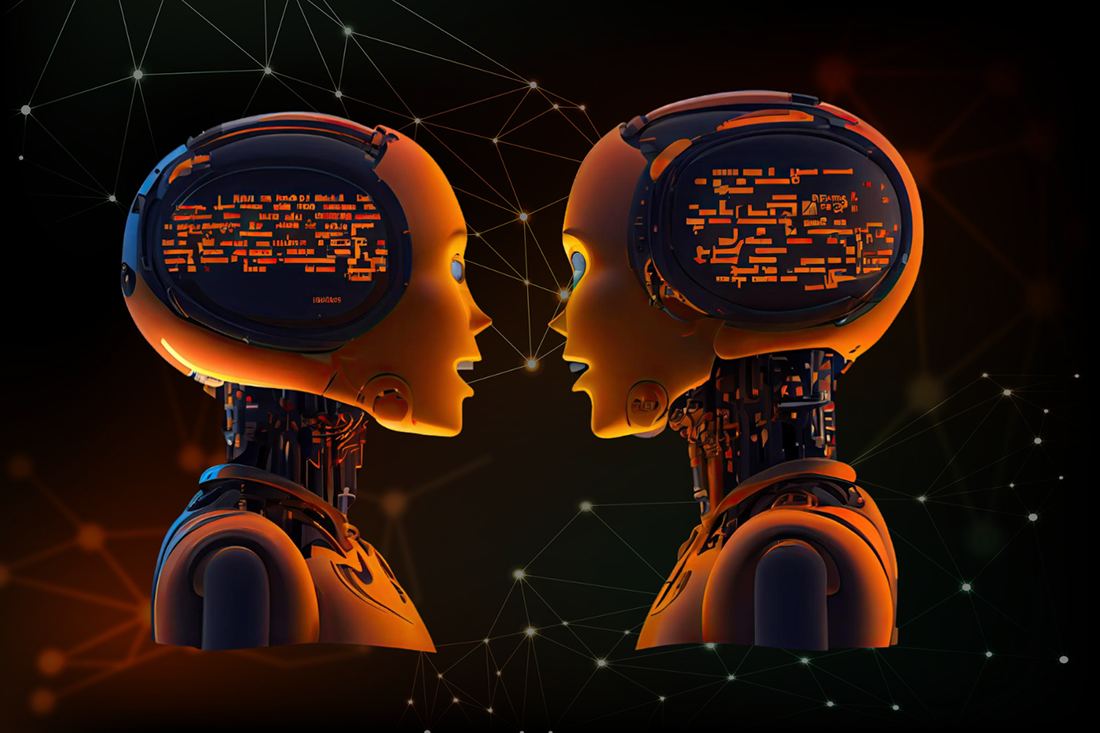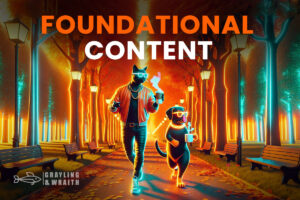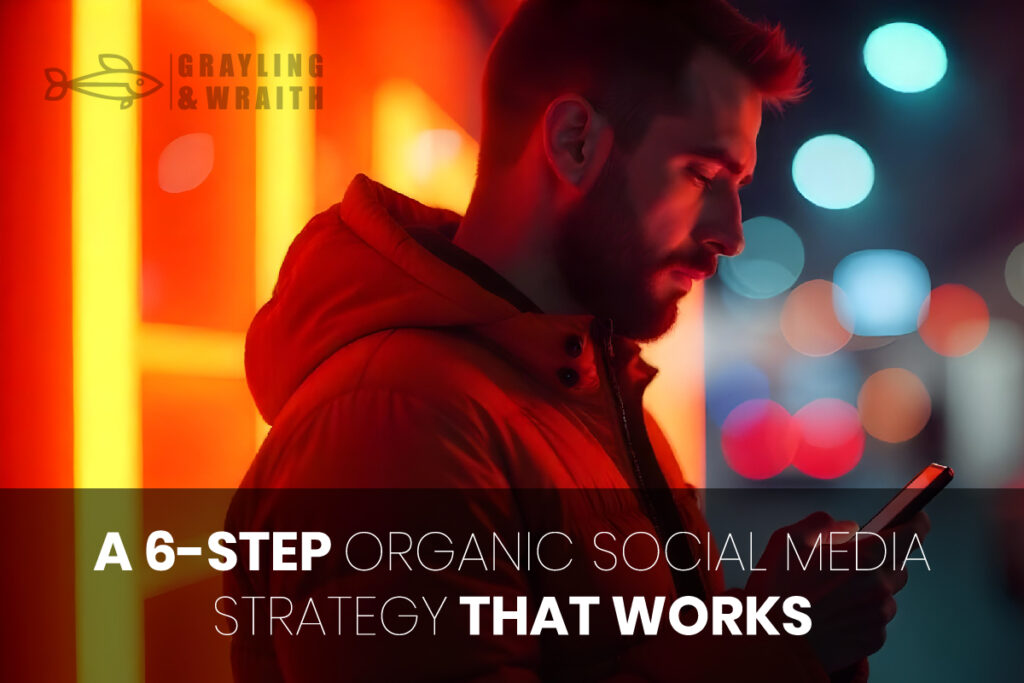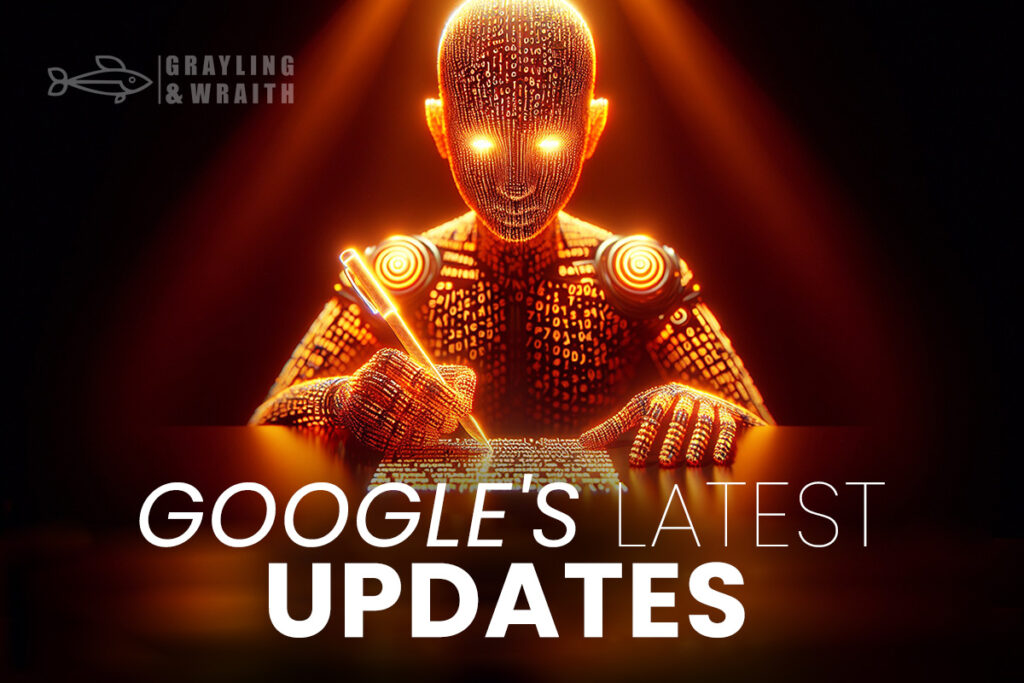GPT-4 vs GPT-3.5: A Leap in AI Evolution
In the rapidly evolving world of technology, we’re inching closer to the realm of science fiction every day. Artificial intelligence (AI) and natural language processing (NLP) stand at the forefront of this revolution, painting a future where machines can understand, communicate, and generate written content with an uncanny resemblance to human fluency. Furthermore, This article will guide you through the fascinating journey from GPT-3.5 to GPT-4, focusing on the GPT-4 vs GPT-3.5 differences.
Think of AI models as superheroes in constant evolution, each version more powerful than the last. In this article, we’ll navigate the GPT (Generative Pre-trained Transformer) series, shedding light on what sets GPT-4 apart from its predecessor, GPT-3.5.
The AI landscape is changing at a breathtaking pace. Moreover, Each advancement brings groundbreaking progress. The GPT series has been instrumental in this journey, with GPT-4 representing a significant leap in AI capabilities. As we delve deeper into this ever-evolving technology, we’ll uncover the magic of GPT-4 and how it’s revolutionizing our interaction with AI-generated text, underlining the pivotal GPT-4 vs GPT-3.5 advancements. So, buckle up as we embark on an exciting journey into a world where technology continually pushes the boundaries of human-AI collaboration.
GPT-3 vs. GPT-3.5: The Bridge to Evolution
Laying the Groundwork: The Role of GPT-3.5
Understanding the monumental leap from GPT-3 to GPT-4 requires us to delve into the crucial role of GPT-3.5. Here, the GPT-4 vs GPT-3.5 evolution becomes apparent, as we see GPT-3.5 laying the groundwork for the more advanced capabilities of GPT-4. Initially, GPT-3, the third iteration of OpenAI’s revolutionary language model, made its debut with a staggering 175 billion parameters. This digital powerhouse could generate text that was strikingly human-like, crafting informative articles on diverse topics and engaging in coherent conversations. Despite its impressive capabilities, GPT-3 had limitations, particularly in maintaining contextual coherence.
Refinement and Mastery with GPT-3.5
GPT-3.5 emerged as the unsung hero, refining the art of text generation. The transition from GPT-3 to GPT-3.5 might seem subtle at first glance, but it marked a significant milestone. Indeed, the magic of GPT-3.5 lay in fine-tuning and prompt engineering, techniques that transformed it into an AI maestro, orchestrating a symphony of words with improved contextual understanding.
Contextual Awareness: A Case Study
Consider this example: If you were interacting with a GPT-3-based chatbot and asked about “Apple,” GPT-3 might provide a detailed response about the fruit. However, if you then asked about “Apple’s latest products,” it might struggle to realize you’ve shifted the context to a tech company. GPT-3.5, on the other hand, would effortlessly recognize the shift in context and provide an insightful reply about Apple Inc.’s latest product releases.
The Evolutionary Leap: From GPT-3 to GPT-4
This evolutionary leap from GPT-3 to GPT-3.5 served as the essential bridge, preparing GPT-3 for the boundless landscape of GPT-4, which we’ll explore further in this article. The journey from GPT-3 to GPT-4 isn’t merely a series of upgrades; it’s a transformational odyssey that underscores the relentless pursuit of excellence in AI and natural language processing.
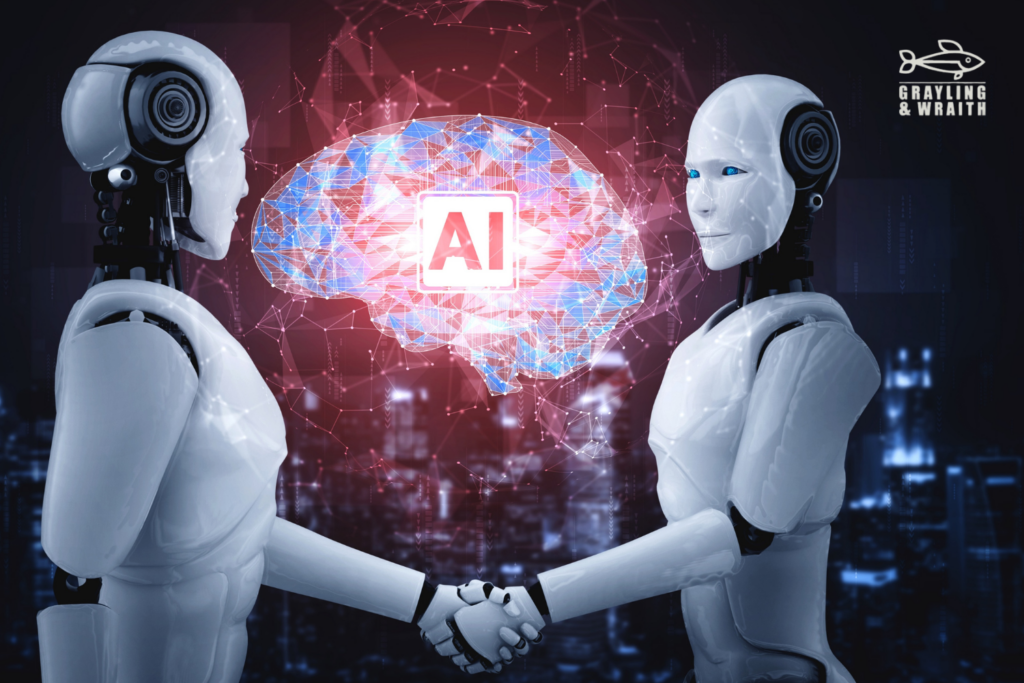
GPT-4: A Revolutionary Leap in AI-Language Models
GPT-4, the latest marvel in the lineage of AI language models, heralds a new era in text generation and understanding, marking a stark contrast in the GPT-4 vs GPT-3.5 journey. Its advancements over its predecessors are not just incremental but revolutionary. With an astounding number of parameters, GPT-4 exhibits an unprecedented depth of context understanding. Picture GPT-4 as a scholar who not only knows the words but also grasps the subtleties of their usage in various contexts. It’s not merely about arranging words; it’s about crafting a rich tapestry of context and coherence.
Beyond Word Processing: Understanding Intentions with GPT-4
Consequently, the impact of GPT-4 reverberates across the entire AI field. Unlike its predecessors, GPT-4 doesn’t just process words; it comprehends intentions. For instance, if you ask, “What’s the weather like in the city that never sleeps?” GPT-4 doesn’t just retrieve weather data; it infers that you’re referring to New York, the Big Apple. It’s like engaging in a conversation with a brilliant mind that anticipates your thoughts, akin to a seasoned chess player who strategizes multiple moves ahead.
GPT-4’s Multifaceted Applications Across Industries
Moreover, GPT-4’s enhanced capabilities span across various industries. In healthcare, GPT-4 can read and comprehend complex medical journals, aiding doctors in making accurate diagnoses. It becomes a versatile ghostwriter in content creation, producing everything from gripping novels to technical manuals. For example, suppose you ask GPT-4 to create a marketing slogan for a luxury watch. In that case, it not only generates the tagline but also provides a backstory that embodies sophistication and craftsmanship. It’s like GPT-4 dons multiple hats, effortlessly transitioning from a scientist’s lab coat to a poet’s quill.
This isn’t merely a progression; it’s a revolution. GPT-4 reshapes the AI landscape, fundamentally redefining the essence of human-AI interaction. Indeed, it’s the key to unlocking new frontiers, where AI is not just a tool but a creative collaborator, elevating the art of text generation and understanding to unparalleled heights.
GPT-4 vs. GPT-3: The Power of Tokens
To truly appreciate the revolutionary leap represented by GPT-4, especially in the context of GPT-4 vs GPT-3.5, we need to delve into the world of tokens. Tokens, which include words, subwords, and even individual characters, are the fundamental units of text that AI models use to read and interpret text. Significantly, the real game-changer with GPT-4 is its expanded and more comprehensive vocabulary, allowing it to process significantly larger tokens than GPT-3.
Amplified Token Capacity:
GPT-4’s token capacity is like expanding an orchestra with more musicians and a broader repertoire. While GPT-3 might work with a limited ensemble, GPT-4 commands a grand orchestra. It can process entire books, comprehensive legal documents, or lengthy conversations. Its capacity extends beyond mere paragraphs or pages; it can analyze entire volumes in one sweep.
Historical Archives and Manuscripts:
For historians and archivists, this is a game-changer. While GPT-3’s analysis of historical manuscripts might involve breaking them into manageable pieces, GPT-4 takes a holistic approach. It can ingest an entire archive, from ancient scrolls to handwritten letters, providing comprehensive summaries and insights. GPT-4 is like a historian with a photographic memory.
Mastering Content Creation:
GPT-4 is more than a content creator; it’s a content virtuoso. While GPT-3 may have produced paragraphs and short articles, GPT-4 drafts complete books, maintaining thematic consistency throughout. It’s not just an assistant; it’s a co-author who understands the intricacies of plot, character development, and tone.
Dynamic Conversation Maestro:
In terms of conversations, GPT-4 is the maestro conducting a symphony of dialogue. While GPT-3 may struggle to maintain context over extended exchanges, GPT-4 retains context across numerous exchanges, ensuring responses align seamlessly with the ongoing discourse. This makes it an ideal partner for complex, multi-step projects, from collaborative writing to customer support.
The difference in token capacity between GPT-4 and GPT-3 isn’t just about quantity; it’s a qualitative transformation. GPT-4 redefines the boundaries of text generation and understanding, elevating AI’s role in industries, research, and communication to an unprecedented level. It’s like moving from a limited color palette to a spectrum of possibilities.
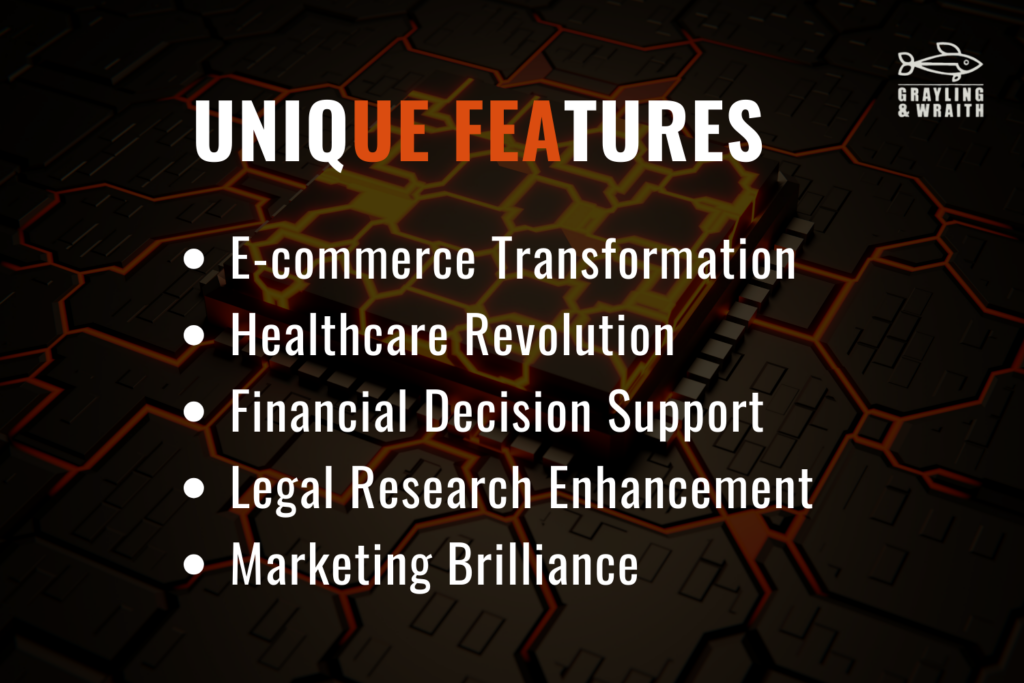
Unique Features of GPT-4
GPT-4 is not just another step in the evolution of AI; it’s a monumental leap characterized by unique features that redefine the capabilities of language models. This leap is most evident when examining the GPT-4 vs. GPT-3.5 comparison. One distinguishing feature of GPT-4 is its extraordinary ability to handle multi-modal inputs, seamlessly integrating text and images to understand and generate content. This has profound implications across various industries, highlighting the advancements from its predecessor.
E-commerce Transformation:
For instance, imagine enhancing the online shopping experience in the e-commerce sector. GPT-4 can analyze an image of a product along with its written description, effortlessly generating visually appealing and SEO-friendly product listings. This is a game-changer, enabling online retailers to engage customers with immersive, information-rich listings.
Healthcare Revolution:
Similarly, in the healthcare sector, GPT-4 serves as an intelligent diagnostician. It can sift through extensive medical records, research papers, and journals. It quickly extracts insights that aid in accurate diagnosis and personalized treatment plans. Thus, the result is a proactive, data-driven, and highly efficient healthcare system.
Financial Decision Support:
In finance, GPT-4 becomes a trusted advisor for traders and investors. It can analyze vast volumes of market data, generating investment reports that assist traders in making informed, data-backed decisions. Its ability to process and interpret financial news and trends in real-time is invaluable in the dynamic world of finance.
Legal Research Enhancement:
In the legal domain, GPT-4 is an invaluable ally that can swiftly scan and summarize complex legal documents. This allows legal professionals to streamline their research, making it thorough and efficient. As a result, the legal industry can focus more on strategy and less on laborious document analysis.
Marketing Brilliance:
In content creation, GPT-4 is more than capable. Consider a marketing campaign for a luxury car brand. GPT-4 doesn’t merely generate content; it weaves an entire brand narrative. From crafting compelling taglines to painting vivid imagery, it captures the essence of sophistication, captivation, and desire. Thus, marketers find in GPT-4 a creative partner that elevates campaigns to an art form.
Furthermore, GPT-4 transcends its role as a tool in each of these examples. It becomes an indispensable partner that redefines workflows, enhances productivity, and opens new horizons for creativity and innovation. Indeed, GPT-4’s unique multi-modal capabilities and its profound understanding of context are revolutionizing how industries work and interact with AI-driven text.
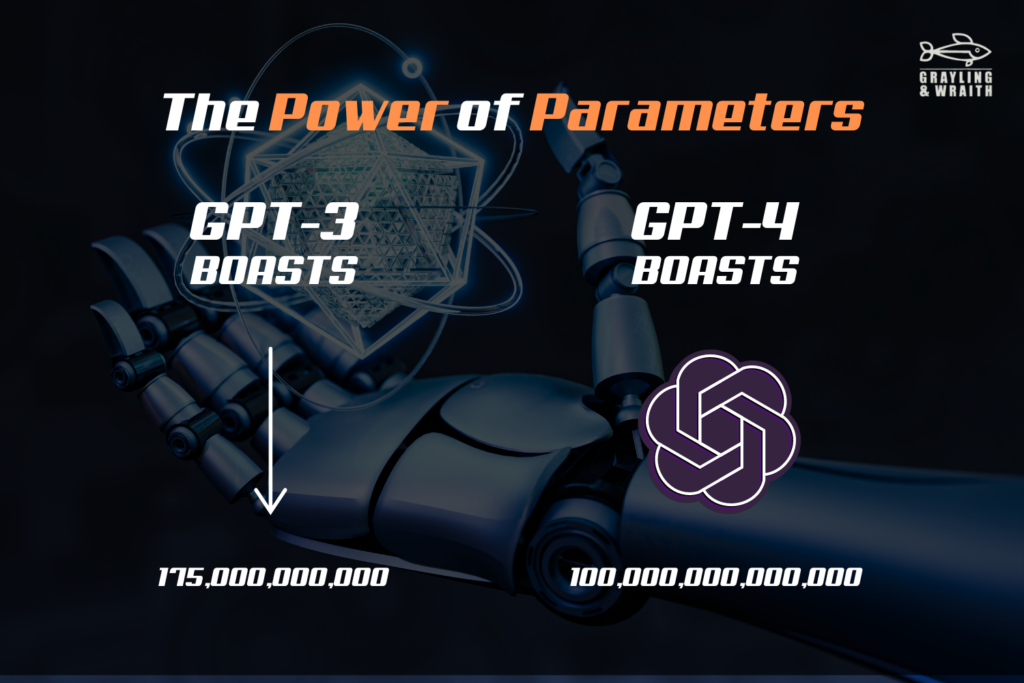
GPT-4: Unveiling the Power of Parameters
In AI models, the number of parameters is a critical metric that signifies the model’s capabilities. GPT-4, with its extraordinary parameter count, surpasses even its groundbreaking predecessor, GPT-3, which boasts 175 billion parameters. This significant increase in parameters is a core aspect of the GPT-4 vs GPT-3.5 evolution. But what does this number truly mean, and why is it significant?
Parameters in AI models are akin to digital synapses, forming the foundation of the model’s knowledge and understanding. A higher parameter count equates to a more extensive neural network, capable of processing and storing more information. It’s like comparing a basic dictionary to a vast library; while the dictionary knows the meanings of words, the library understands the rich tapestry of language usage, from idiomatic expressions to context-dependent subtleties.
However, GPT-4’s parameter surge signifies more than numerical growth; it represents a transformation in AI capabilities. GPT-4’s expanded parameter count enables a deeper understanding of context and nuance, extending far beyond a quantitative increase. This qualitative leap in parameter count is a pivotal distinction in the GPT-4 vs GPT-3.5 comparison. It functions as a diagnostic expert in healthcare, a legal research assistant, and a masterful storyteller, often rivaling human creativity.
Moreover, this increase in parameter count isn’t just a quantitative upgrade; it’s a qualitative transformation. It empowers GPT-4 with an expanded capacity for learning and comprehension, making it an AI tool capable of handling complex tasks, from interpreting extensive documents to generating text that rivals human quality. The significance of GPT-4’s increased parameter count is its ability to push the boundaries of AI’s role in understanding text. It also allows AI to develop text to entirely new dimensions.
GPT-4’s Parameter Revolution:
At its core, GPT-4’s most striking feature is its unparalleled parameter count. With a neural network surpassing that of GPT-3, it demonstrates an unprecedented understanding of language. The implications are far-reaching, as GPT-4 emerges as a diagnostic expert in healthcare, a legal research assistant, and a creative partner in content generation.
A Creative Collaborator:
GPT-4’s significance lies in its transformation from a tool to a versatile and creative collaborator. Its multi-modal capabilities enhance industries like e-commerce. In this sector, it crafts visually appealing and SEO-optimized product listings, seamlessly integrating text and images for an immersive shopping experience.
The Unending Journey of AI:
As we conclude, it’s essential to acknowledge that the world of AI is in constant motion. GPT-4, marking a significant milestone in the GPT-4 vs GPT-3.5 narrative, is part of this ever-evolving story. Staying abreast of the latest advancements, such as the leap from GPT-3.5 to GPT-4, is vital, for it’s a journey that continuously redefines human-machine collaboration.
The road ahead is brimming with promise, and staying informed means we unlock the boundless potential of AI and NLP. The GPT-4 vs GPT-3.5 evolution exemplifies how AI is blurring the lines between human and machine capabilities, leading us into a future that unfolds as a realm of limitless possibilities.
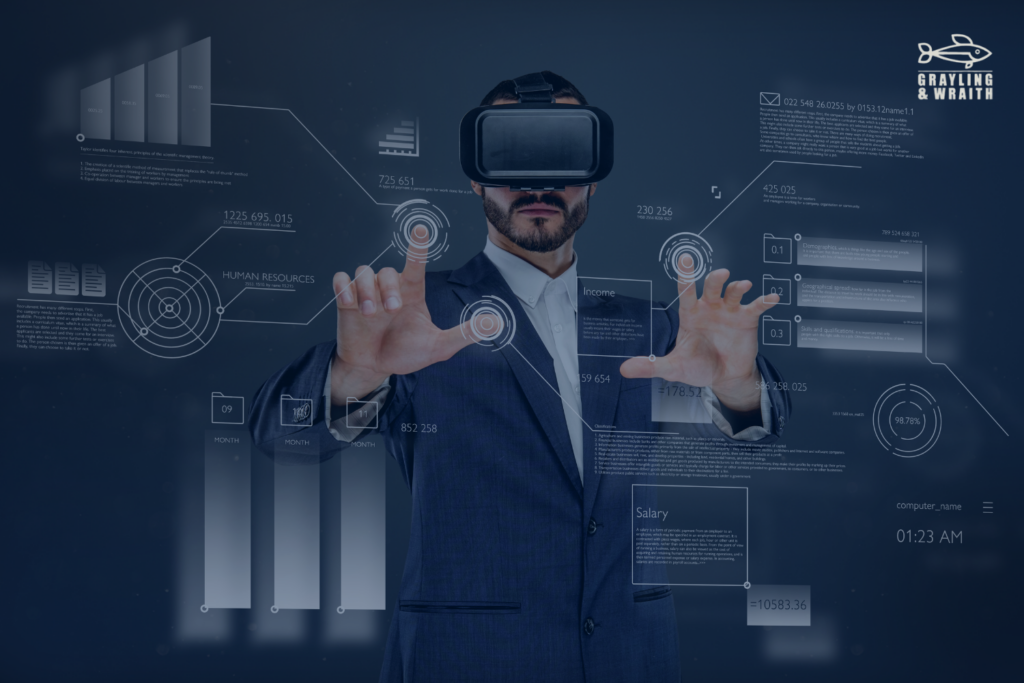
GPT-4: A Paradigm Shift and the Ongoing AI Odyssey
The transition from GPT-3 to GPT-4 is a testament to the relentless evolution within AI and Natural Language Processing. Moreover, GPT-4’s significant leap in parameter count signifies a transformative shift in the capabilities of language models. Its deep understanding of context and multi-modal capabilities has redefined its role across various industries.
Unveiling Boundless Potential: The GPT-4 vs GPT-3.5 Evolution in AI:
Beyond numerical growth, GPT-4 represents a qualitative advancement in AI, particularly when examining the GPT-4 vs GPT-3.5 advancements. Its applications span across crucial sectors: in healthcare, it enhances diagnostic precision; in law, it accelerates data synthesis; and in creative fields, it emerges as an unparalleled storyteller.
A Glimpse into Tomorrow:
As we conclude this exploration, we acknowledge that GPT-4 is a milestone in an ever-evolving narrative of AI innovation. Staying informed amidst this dynamic landscape, especially in the context of GPT-4 vs GPT -3.5, is key, as the future promises further strides, blurring the lines between human and machine capabilities. GPT-4 serves as both a tool and a herald of AI’s boundless potential.

